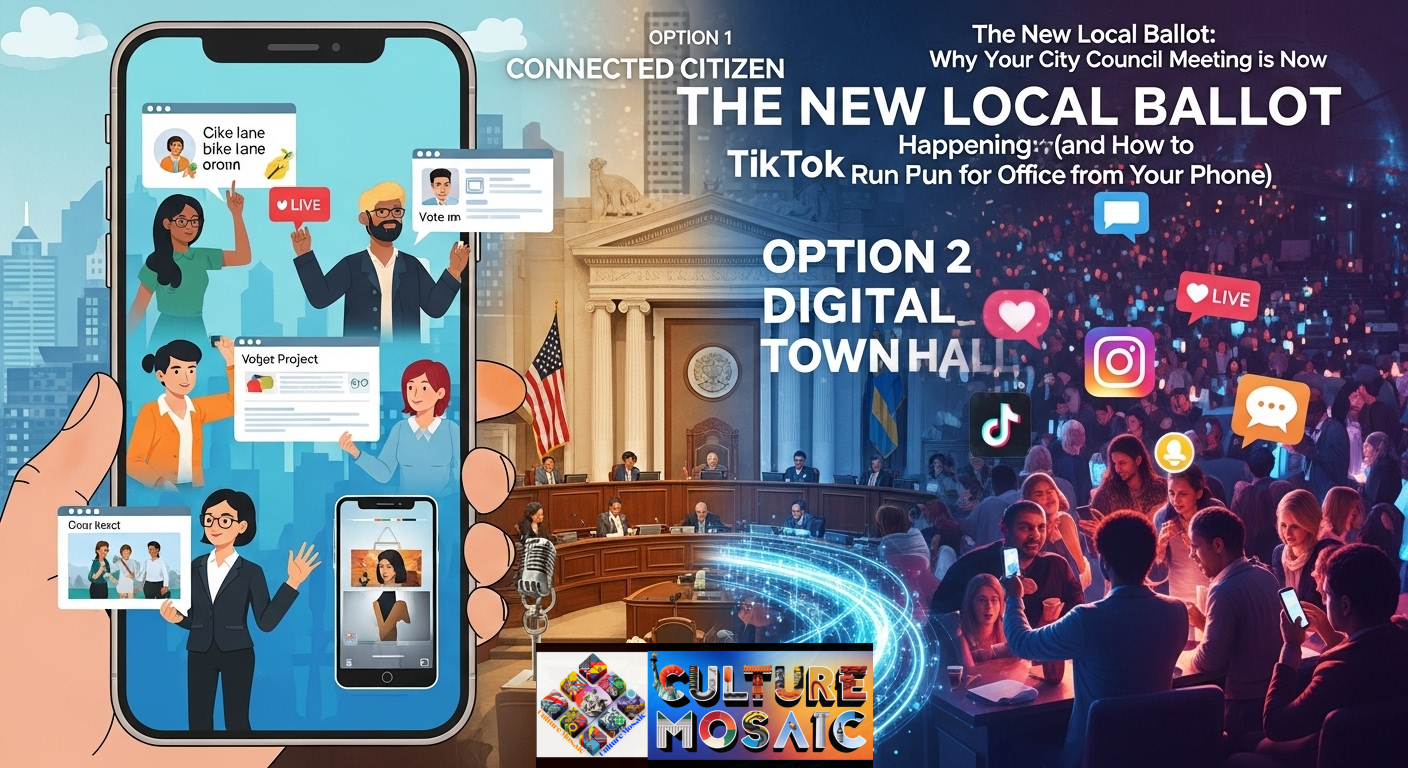Local politics has gone digital, and it’s changing everything about how Americans participate in democracy. City council meetings that once attracted a handful of residents now stream to thousands on Instagram Live. Town halls happen in comment sections. And yes, elected officials are actually responding to constituent concerns through TikTok videos.
This isn’t just a novelty. Digital civic engagement is rebuilding the bridge between citizens and their local governments, one notification at a time. For Gen Z and millennial voters who grew up with smartphones in hand, participating in democracy now feels as natural as scrolling through a feed.
What is Digital Civic Engagement?
Digital civic engagement refers to the use of online platforms, mobile apps, and digital tools to participate in democratic processes and influence public policy. It encompasses everything from attending virtual town halls to using geospatial mapping tools that let you weigh in on where your city should build its next bike lane.
Unlike traditional civic participation that required showing up to a government building during business hours, digital civic engagement meets you where you already are: online. It’s democracy redesigned for how we actually live today.
The Digital Town Hall: From City Hall to Your Feed
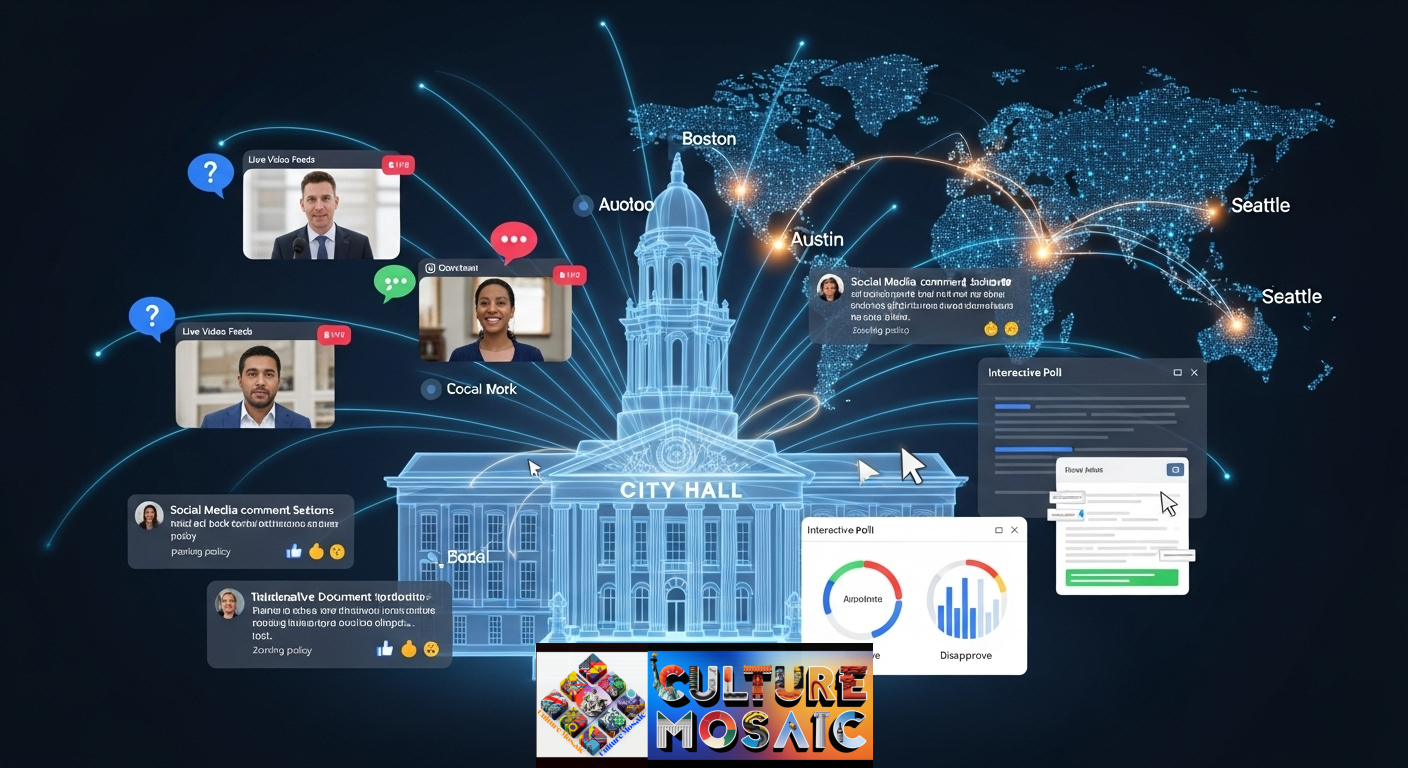
Remember when participating in local government meant taking time off work to sit through a three-hour city council meeting? Those days are fading fast.
Local officials across the United States are now using social media as their primary communication channel. The mayor of your city might host Instagram Live Q&A sessions where residents ask questions in real time. Your city council representative probably has a TikTok where they explain new ordinances in 60-second videos. Local subreddits have become unofficial town squares where neighbors debate everything from parking policy to school board decisions.
This shift represents a fundamental change in digital civic engagement. Instead of information flowing one way (from government to citizen through official press releases), we now have genuine two-way conversations. When a council member posts about a proposed zoning change, hundreds of residents can comment, share their perspectives, and influence the decision before the final vote.
The transparency matters too. Young voters consistently report low trust in government institutions, but seeing their local officials speak directly to them, unfiltered and unscripted, helps rebuild that connection. When you can literally watch your representative think through a question you asked, the government stops feeling like a black box.
Cities like Boston, Austin, and Seattle have embraced this model wholeheartedly. Their digital civic engagement strategies include regular social media office hours, polls that actually influence policy decisions, and even collaborative Google Docs where residents can suggest edits to proposed legislation.
Crowdsourced Policy: The Rise of Geospatial and Participatory Tools
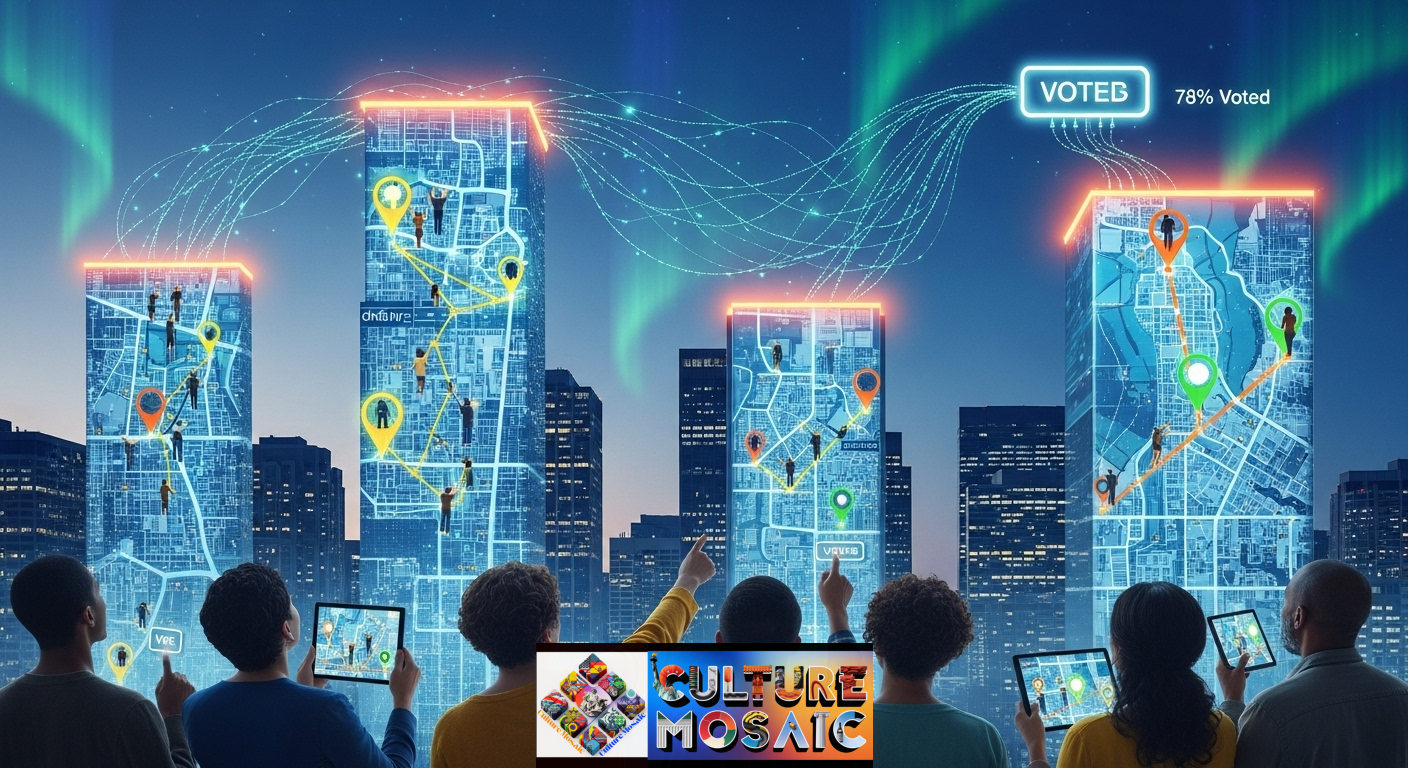
Digital civic engagement goes far beyond social media. Cities are now deploying sophisticated digital tools that let residents directly shape their communities.
Interactive Mapping Platforms
Geospatial tools have revolutionized how cities gather community input. Instead of abstract discussions about “improving neighborhoods,” residents can now click on an interactive map and leave specific feedback about their streets.
Planning a new protected bike lane? The city drops a proposed route on a digital map, and residents mark dangerous intersections, suggest alternative paths, or endorse the plan. Considering where to install new street lights? Residents can pinpoint exactly which corners feel unsafe after dark.
These platforms make civic participation tangible. You’re not just voicing an opinion into the void; you’re literally pointing at the physical space you want to improve. Cities like New York, Chicago, and Portland use platforms like Maptionnaire and CommonPlace to collect this hyperlocal feedback, and the data directly influences final project designs.
Participatory Budgeting Goes Digital
Perhaps the most exciting innovation in digital civic engagement is online participatory budgeting. The concept is simple but powerful: cities set aside a portion of their budget and let residents vote on how to spend it.
The digital transformation makes this process accessible to everyone. Rather than attending multiple in-person meetings, residents can browse proposed projects online (new playground equipment, street repairs, community garden funding), review cost estimates, and cast their votes from their phones.
New York City pioneered this approach in the US, and now dozens of cities have followed. Participation rates for digital participatory budgeting consistently exceed traditional methods by huge margins. When Boston launched its digital platform, it saw a 300% increase in participants compared to their previous paper-based system.
This direct control over public spending creates a sense of ownership. You’re not just asking the government to fix something; you’re actively deciding what gets fixed and how. That transforms the relationship between citizens and their city from passive to collaborative.
The Micro-Campaign: Running for Office from Your Phone
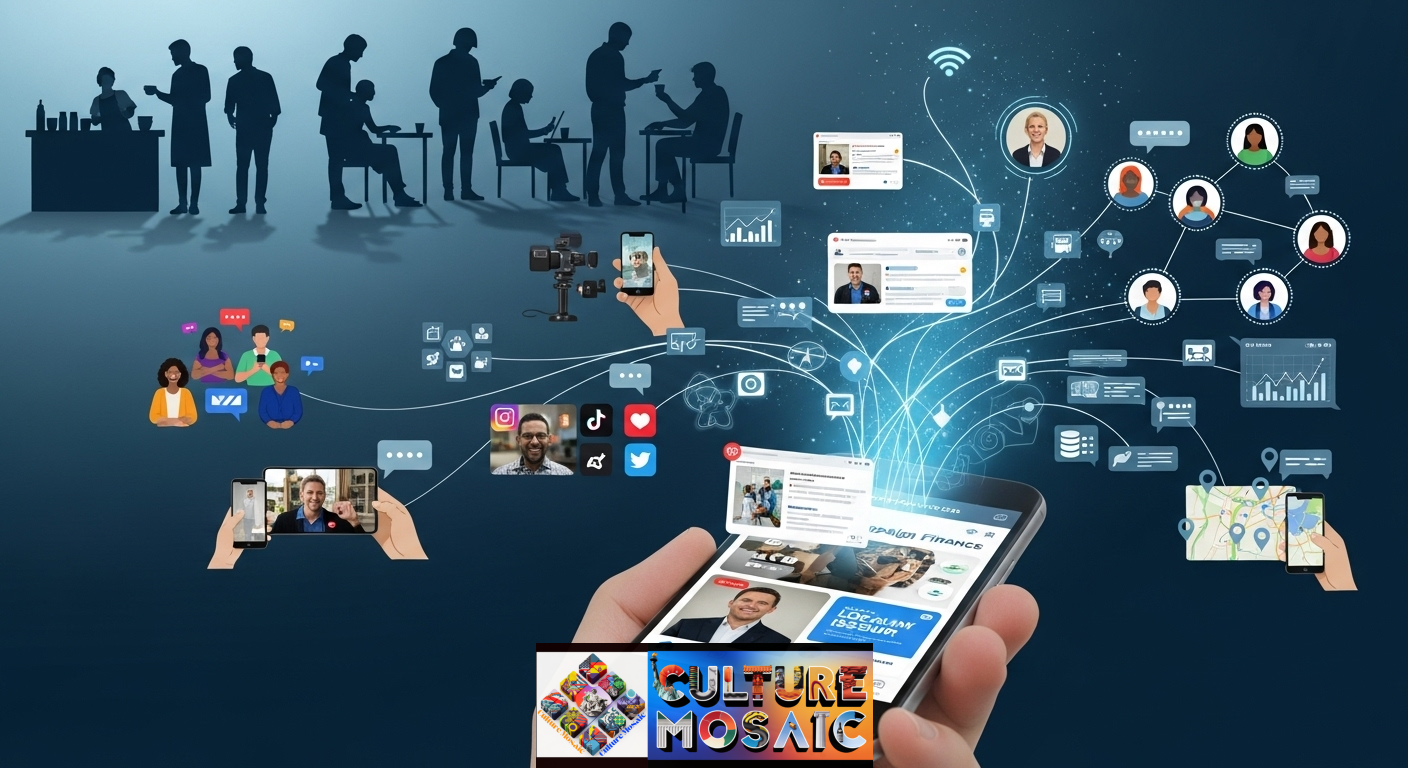
Digital civic engagement isn’t just changing how we participate in politics. It’s changing who can participate.
Running for local office used to require significant financial resources, political connections, and name recognition. You needed yard signs, direct mail campaigns, and probably a professional campaign manager. That infrastructure automatically excluded most regular people who wanted to serve their communities.
Digital tools have demolished those barriers.
Young, first-time candidates are now running competitive campaigns with budgets under $5,000. They’re using Instagram Stories to introduce themselves to voters. They’re creating TikTok explainers about local issues that go viral in their districts. They’re organizing volunteer networks through group chats and mobilizing supporters with peer-to-peer texting apps.
The content itself matters more than the production budget. A genuine, selfie-video explaining why affordable housing matters to you personally often resonates more than a polished TV ad. User-generated content from supporters (neighbors filming short testimonials on their phones) builds grassroots credibility that money can’t buy.
Digital civic engagement platforms like Mobilize help candidates organize canvassing events and volunteer shifts. Tools like NationBuilder let campaigns manage supporter databases and coordinate outreach. Even campaign finance reporting has digital solutions that simplify the administrative burden.
This democratization of political campaigns means we’re seeing more diverse candidates. Young people, working-class residents, and community activists who were previously locked out of the political system can now run viable campaigns. Your barista might be your next city council member, and they probably announced their candidacy in an Instagram post.
Several Gen Z candidates have already won local elections across the US using predominantly digital strategies. They prove that digital civic engagement isn’t just about consuming political content; it’s about creating it, sharing it, and ultimately winning elections with it.
From Hashtag to Real Change: Making Digital Engagement Meaningful
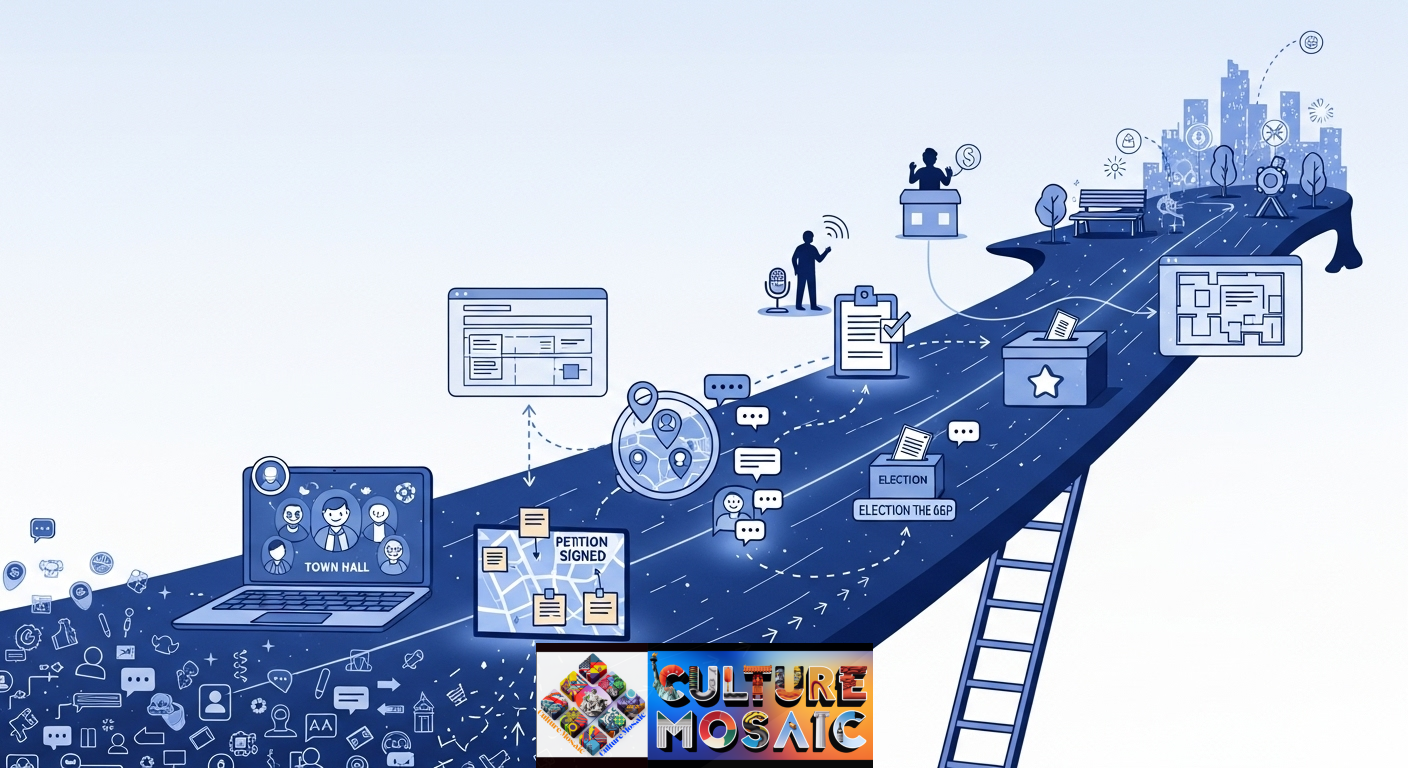
Here’s the hard truth about digital civic engagement: it only works if digital action translates to real-world impact.
We’ve all seen the cycle. An issue goes viral. Everyone changes their profile pictures. The hashtag trends. And then… nothing actually changes. Critics call this “slacktivism,” the feel-good activism that requires no sacrifice and produces no results.
But dismissing all digital civic engagement as performative misses the point. The question isn’t whether digital activism is valuable (it is), but rather how we bridge the gap between online awareness and offline action.
Sustainable Digital Civic Engagement
The most effective digital civic engagement campaigns follow a clear path from awareness to action:
- Information Sharing: A local issue gains attention through social media posts, videos, or online articles. This creates awareness and gets people emotionally invested.
- Digital Organization: Interested residents join online groups, Discord servers, or messaging channels where they can coordinate and share resources. The digital space becomes an organizing hub.
- Hybrid Participation: The group uses digital tools to amplify real-world actions. They livestream protests so more people can witness them. They use shared documents to coordinate who will speak at city council meetings. They post updates that keep the momentum going between in-person events.
- Measurable Outcomes: The campaign celebrates tangible wins (a policy change, a budget allocation, an election result) and shares those victories online to demonstrate that participation matters.
Cities leading in digital civic engagement have learned to design this bridge intentionally. They don’t just collect input online; they create clear feedback loops showing residents how their digital participation influenced real decisions.
Boston’s “City Hall to Go” program exemplifies this approach. Residents report neighborhood issues through a mobile app (digital), city workers respond and fix the problems (real-world), and the app updates with before-and-after photos (digital again). This closed loop proves that digital civic engagement creates tangible results.
The Participation Ladder
Think of digital civic engagement as a ladder. Different people enter at different rungs, and the goal is to help them climb higher:
- Bottom rung: Following local officials on social media, liking posts about community issues
- Middle rungs: Commenting on proposed policies, attending virtual town halls, signing digital petitions, using participatory mapping tools
- Top rungs: Volunteering for campaigns, organizing community events, running for office, consistently showing up at city council meetings
Digital tools make it easy to start at the bottom rung. The challenge is designing pathways that encourage people to keep climbing. The most successful digital civic engagement strategies explicitly create these pathways, regularly inviting people to take one step further in their participation.
The Future of Digital Civic Engagement
We’re still in the early days of digital democracy. The tools will improve, platforms will evolve, and new technologies will create possibilities we haven’t imagined yet.
Some cities are experimenting with blockchain-based voting systems for participatory budgeting, ensuring transparency and preventing fraud. Others are using AI-powered chatbots that can answer residents’ questions about city services 24/7. Virtual reality might soon let you “attend” city council meetings from your living room, with the same immersive feeling as being physically present.
But the technology itself isn’t the point. Digital civic engagement matters because it makes democracy more accessible, more transparent, and more responsive to the people it serves.
For Gen Z voters who came of age during a pandemic, digital civic engagement isn’t a novelty; it’s the baseline expectation. They don’t understand why participating in democracy should be harder than ordering food delivery. They expect their government to meet them where they are, speak their language, and actually listen.
Cities that embrace digital civic engagement are building trust with the next generation of voters. Those that don’t risk becoming increasingly irrelevant as younger residents simply opt out of civic life entirely.
How to Start Your Digital Civic Engagement Journey Today
Ready to get involved? Here’s how to start:
- Follow your local officials on social media. Find your city council members, mayor, and county representatives. Turn on notifications so you see their updates.
- Join local online communities. Search for your city or neighborhood on Reddit, Facebook Groups, or Nextdoor. These spaces often discuss issues before they hit official government agendas.
- Download your city’s app. Many cities now have official apps for reporting issues, tracking city services, or staying informed about local news.
- Attend one virtual meeting. Most city councils now stream their meetings and accept public comment remotely. Pick one issue you care about and show up (virtually).
- Use participatory tools. If your city has participatory budgeting, geospatial feedback platforms, or digital surveys, contribute your perspective.
- Amplify local issues. When you see important community news, share it. Tag your representatives. Help information spread beyond the usual politically engaged circles.
- Consider running for something. Your local parks board, school committee, or city council probably has openings. Digital civic engagement has lowered the barriers enough that “regular people” can now run and win.
Digital civic engagement isn’t replacing traditional democracy. It’s upgrading it for the 21st century. Your voice matters, your vote counts, and now you can participate in democracy without ever leaving your couch. Though honestly, you should probably leave your couch sometimes, too. That city council meeting might be on TikTok, but they still serve better snacks in person.
Frequently Asked Questions About Digital Civic Engagement
Q: Is digital civic engagement as effective as traditional in-person participation?
Digital civic engagement complements rather than replaces traditional participation. Studies show that cities using digital tools see higher overall participation rates, especially among young people and working parents who face barriers to in-person attendance. The most effective approach combines both digital and traditional methods, using online platforms to broaden participation while maintaining in-person options for those who prefer them.
Q: How do I know if my local government uses digital civic engagement tools?
Visit your city or county’s official website and look for sections on “Get Involved,” “Participate,” or “Community Engagement.” Many cities list their digital platforms, social media accounts, and participation opportunities in one place. You can also call your city clerk’s office directly and ask what digital tools they offer for resident participation.
Q: Can digital civic engagement really influence government decisions, or is it just for show?
When properly implemented, digital civic engagement directly influences policy decisions. Cities with successful programs publish reports showing how community input shaped final outcomes. Look for governments that create clear feedback loops, showing residents exactly how their participation affected decisions. Cities committed to meaningful digital civic engagement will demonstrate transparency about this process.
Q: What are the risks or downsides of digital civic engagement?
Digital civic engagement can create a “digital divide” where residents without reliable internet access or digital literacy get left behind. There’s also the risk of online harassment, echo chambers, and misinformation spreading through digital channels. Effective programs address these concerns by maintaining non-digital participation options, moderating online spaces, and providing digital literacy resources for residents who need them.
Q: Do I need to be a tech expert to participate in digital civic engagement?
Not at all. Most digital civic engagement platforms are designed to be as simple as using social media or sending a text message. If you can navigate Facebook or Instagram, you have the skills needed to participate. Many cities also offer training sessions or help desks for residents who want support learning to use new digital tools. The goal is to make participation easier, not harder.

